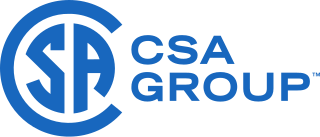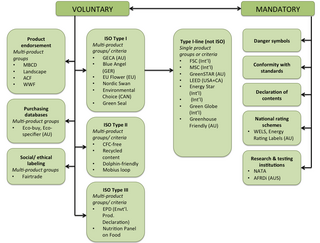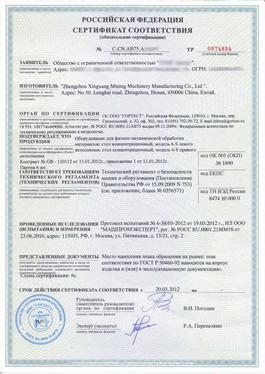
Safety is the state of being "safe", the condition of being protected from harm or other danger. Safety can also refer to the control of recognized hazards in order to achieve an acceptable level of risk.

A certification mark on a commercial product indicates the existence of an accepted product standard or regulation and a claim that the manufacturer has verified compliance with those standards or regulations. The specific specification, test methods, and frequency of testing are published by the standards organization. Certification listing does not necessarily guarantee fitness-for-use. Validation testing, proper usage, and field testing are often needed.
Consumer Reports (CR), formerly Consumers Union (CU), is an American nonprofit consumer organization dedicated to independent product testing, investigative journalism, consumer-oriented research, public education, and consumer advocacy.
The United States Pharmacopeia (USP) is a pharmacopeia for the United States published annually by the over 200-year old United States Pharmacopeial Convention, a nonprofit organization that owns the trademark and also owns the copyright on the pharmacopeia itself.

The CSA Group is a standards organization which develops standards in 57 areas. CSA publishes standards in print and electronic form, and provides training and advisory services. CSA is composed of representatives from industry, government, and consumer groups.
Consumers' Research is a 501(c)(3) non-profit organization established in 1929 by Stuart Chase and F. J. Schlink after the success of their book Your Money's Worth: a study in the waste of the Consumer's Dollar galvanized interest in testing products on behalf of consumers. It published a monthly magazine called Consumers' Research Bulletin. Leading staff from this organization, thwarted in their efforts to establish a collective bargaining unit of a labor union, protested and left to form Consumers Union in 1936. The magazine published by Consumers Union, initially Consumers Union Reports and now called Consumer Reports, gained popularity and market share over the Bulletin and largely supplanted its relevance.

Ecolabels and Green Stickers are labeling systems for food and consumer products. The use of ecolabels is voluntary, whereas green stickers are mandated by law; for example, in North America major appliances and automobiles use Energy Star. They are a form of sustainability measurement directed at consumers, intended to make it easy to take environmental concerns into account when shopping. Some labels quantify pollution or energy consumption by way of index scores or units of measurement, while others assert compliance with a set of practices or minimum requirements for sustainability or reduction of harm to the environment. Many ecolabels are focused on minimising the negative ecological impacts of primary production or resource extraction in a given sector or commodity through a set of good practices that are captured in a sustainability standard. Through a verification process, usually referred to as "certification", a farm, forest, fishery, or mine can show that it complies with a standard and earn the right to sell its products as certified through the supply chain, often resulting in a consumer-facing ecolabel.
GOST refers to a set of international technical standards maintained by the Euro-Asian Council for Standardization, Metrology and Certification (EASC), a regional standards organization operating under the auspices of the Commonwealth of Independent States (CIS).

Product certification or product qualification is the process of certifying that a certain product has passed performance tests and quality assurance tests, and meets qualification criteria stipulated in contracts, regulations, or specifications.
Listing and approval use and compliance is the practice of installing and operating safety-related products and materials in accordance with to minimum performance conformance testing requirements. The conformance could be for a certification listing or for an approval that has been issued by an organization that is accredited both for testing and product certification. Such organizations include Underwriters Laboratories, FM Global, or the Deutsches Institut für Bautechnik (DIBt).

Toy safety is the practice of ensuring that toys, especially those made for children, are safe, usually through the application of set safety standards. In many countries, commercial toys must be able to pass safety tests in order to be sold. In the U.S., some toys must meet national standards, while other toys may not have to meet a defined safety standard. In countries where standards exist, they exist in order to prevent accidents, but there have still been some high-profile product recalls after such problems have occurred. The danger is often not due to faulty design; usage and chance both play a role in injury and death incidents as well.

100,000,000 Guinea Pigs: Dangers in Everyday Foods, Drugs, and Cosmetics is a book written by Arthur Kallet and F. J. Schlink first released in 1933 by the Vanguard Press and manufactured in the United States of America. Its central argument propounds that the American population is being used as guinea pigs in a giant experiment undertaken by the American producers of food stuffs and patent medicines and the like. Kallet and Schlink premise the book as being "written in the interest of the consumer, who does not yet realize that he is being used as a guinea pig..."
ConsumerLab.com, LLC. is a privately held American company registered in White Plains, NY. It is a publisher of test results on health, wellness, and nutrition products. Consumer Labs is not a laboratory, but contracts studies to outside testing laboratories. It purchases dietary supplement products and other consumer goods directly from public storefronts and online retailers, contracts for testing by private laboratories, and publishes reports based on the results. It primarily derives revenue from the sale of subscriptions to its online publications, which are paywalled. Other sources of revenue include a proprietary certification program, licensing fees, contents re-publication license fees, and advertising.
A specification often refers to a set of documented requirements to be satisfied by a material, design, product, or service. A specification is often a type of technical standard.

The Bureau of Indian Standards (BIS) is the National Standards Body of India under Department of Consumer affairs, Ministry of Consumer Affairs, Food & Public Distribution, Government of India. It is established by the Bureau of Indian Standards Act, 2016 which came into effect on 12 October 2017. The Minister in charge of the Ministry or Department having administrative control of the BIS is the ex-officio President of the BIS. BIS has 500 plus scientific officers working as Certification Officers, Member secretaries of technical committees and lab OIC's.

Food Safety and Standards Authority of India (FSSAI) is a statutory body established under the Ministry of Health & Family Welfare, Government of India. The FSSAI has been established under the Food Safety and Standards Act, 2006, which is a consolidating statue related to food safety and regulation in India. FSSAI is responsible for protecting and promoting public health through the regulation and supervision of food safety.

In Russia, a Certificate of Conformity, also called a Quality Certificate, Safety Certificate or Customs Certificate, affirms that a product or service conforms to legal safety and quality requirements. There are two types of certificate: one demonstrates conformity to the national standards known as GOST, and the other to a particular technical regulation. Certification may take place on either a mandatory or a voluntary basis. The certificate may be obtained: under contract; per consignment; or for serial production of commercial products.
Your Money's Worth: A study in the waste of the consumer's dollar is a 1927 nonfiction book on consumerism written by Stuart Chase and Frederick J. Schlink. It is notable for becoming popular enough to initiate a consumer protection movement. Soon after publication, its authors founded Consumers' Research, the organization that employed the founders of Consumers Union/Consumer Reports.
The consumer movement is an effort to promote consumer protection through an organized social movement, which is in many places led by consumer organizations. It advocates for the rights of consumers, especially when those rights are actively breached by the actions of corporations, governments, and other organizations which provide products and services to consumers. Consumer movements also commonly advocate for increased health and safety standards, honest information about products in advertising, and consumer representation in political bodies.
The ISO 22715 standardCosmetics — Packaging and labelling provides guidelines for manufacturers in the best practices for cosmetic packaging and labelling of all cosmetic products. This standard applies to products that fall under the category of cosmetics that are sold or given away as free samples. ISO 22715 was initially published in April 2006.












